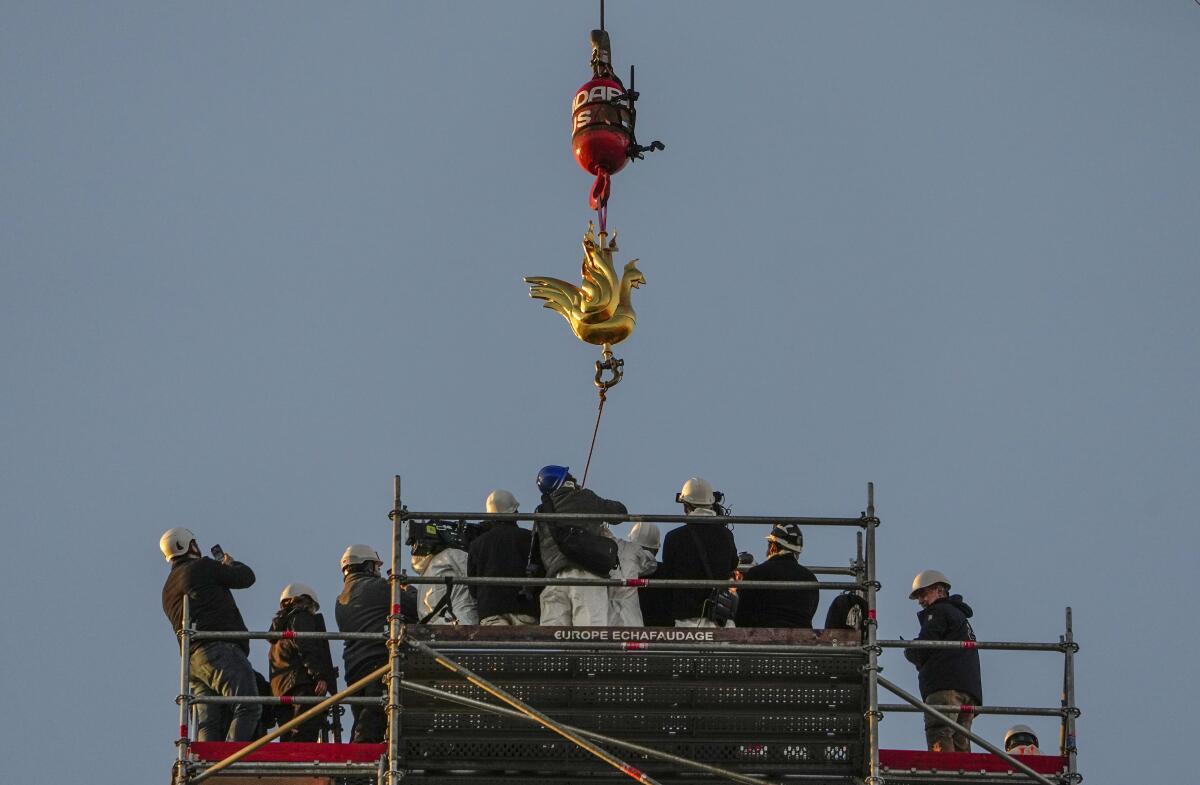Notre Dame Cathedral spire gets back its golden rooster, reimagined as a phoenix

- Share via
PARIS — Notre Dame Cathedral got its rooster back Saturday, in a pivotal moment for the Paris landmark’s restoration.
The installation by a crane of a new golden rooster, reimagined as a dramatic phoenix with licking, flamed feathers, goes beyond being just a weathervane atop the cathedral spire. It symbolizes resilience amid destruction after the devastating April 2019 fire — as restoration officials also revealed that an anti-fire misting system is being installed under the cathedral’s roof.
Chief architect Philippe Villeneuve, who designed the new rooster, stated that the original rooster’s survival signified a ray of light in the catastrophe.
“That there was hope, that not everything was lost. The beauty of the [old] battered rooster ... expressed the cry of the cathedral suffering in flames,” Villeneuve said. He described the new work of art, about half a yard long and gleaming in the December sun behind Notre Dame Cathedral, as his “phoenix.”
A Vatican tribunal has convicted a cardinal of embezzlement and sentenced him to 5 ½ years in prison in one of several verdicts in a financial trial.
Villeneuve elaborated on the new rooster’s significance, saying: “Since [the fire] we have worked on this rooster [the] successor, which sees the flame carried to the top of the cathedral as it was before, more than 96 meters [105 yards] from the ground. ... It is a fire of resurrection.”
In lighthearted comments, the architect said that the process of design was so intense he might have to speak to his “therapist” about it.
Before ascending to its perch, the rooster — a French emblem of vigilance and Jesus Christ’s resurrection — was blessed by Paris Archbishop Laurent Ulrich in a square behind the monument.
The rooster — or coq in French — is an emotive national emblem for the French because of the word’s semantics — the Latin gallus meaning both Gaul and rooster.
Ulrich placed sacred relics in a hole inside the rooster’s breast, including fragments of Christ’s crown of thorns and remains of St. Denis and St. Genevieve, infusing the sculpture with religious importance.
The crown of thorns, regarded as Notre Dame’s most sacred relic, was among the treasures quickly removed after the fire broke out. Brought to Paris by King Louis IX in the 13th century, it is purported to have been pressed onto Christ’s head during the crucifixion. A sealed tube was also placed in the sculpture containing a list of the names of nearly 2,000 individuals who contributed to the cathedral’s reconstruction, underscoring the collective effort behind the works.
Amid the rooster benediction ceremony, Notre Dame’s new restoration chief, Philippe Jost, also detailed pioneering measures taken to safeguard the iconic cathedral against future fires — in rare comments to the press.
“We have deployed a range of fire protection devices, some of which are very innovative in a cathedral, including a misting system in the attics, where the oak frame and in the spire are located,” Jost said. “And this is a first for a cathedral in France.”
French President Emmanuel Macron, who recently visited the site to mark a one-year countdown to its reopening, announced that the original rooster will be displayed in a new museum at the Hotel-Dieu. This move, along with plans to invite Pope Francis for the cathedral’s reopening next year, highlights Notre Dame’s significance in French history and culture.
The rooster’s installation, crowning a spire reconstructed from Eugene Viollet-le-Duc’s 19th century design, is a poignant reminder of its medieval origins as a symbol of hope and faith.
Its long-standing association with the French nation adds to its historical and cultural significance.
More to Read
Sign up for Essential California
The most important California stories and recommendations in your inbox every morning.
You may occasionally receive promotional content from the Los Angeles Times.











